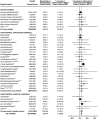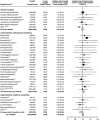Alcohol, tobacco and breast cancer--collaborative reanalysis of individual data from 53 epidemiological studies, including 58,515 women with breast cancer and 95,067 women without the disease - PubMed (original) (raw)
Meta-Analysis
. 2002 Nov 18;87(11):1234-45.
doi: 10.1038/sj.bjc.6600596.
K Hirose, K Tajima, T Rohan, E E Calle, C W Heath Jr, R J Coates, J M Liff, R Talamini, N Chantarakul, S Koetsawang, D Rachawat, A Morabia, L Schuman, W Stewart, M Szklo, C Bain, F Schofield, V Siskind, P Band, A J Coldman, R P Gallagher, T G Hislop, P Yang, L M Kolonel, A M Y Nomura, J Hu, K C Johnson, Y Mao, S De Sanjosé, N Lee, P Marchbanks, H W Ory, H B Peterson, H G Wilson, P A Wingo, K Ebeling, D Kunde, P Nishan, J L Hopper, G Colditz, V Gajalanski, N Martin, T Pardthaisong, S Silpisornkosol, C Theetranont, B Boosiri, S Chutivongse, P Jimakorn, P Virutamasen, C Wongsrichanalai, M Ewertz, H O Adami, L Bergkvist, C Magnusson, I Persson, J Chang-Claude, C Paul, D C G Skegg, G F S Spears, P Boyle, T Evstifeeva, J R Daling, W B Hutchinson, K Malone, E A Noonan, J L Stanford, D B Thomas, N S Weiss, E White, N Andrieu, A Brêmond, F Clavel, B Gairard, J Lansac, L Piana, R Renaud, A Izquierdo, P Viladiu, H R Cuevas, P Ontiveros, A Palet, S B Salazar, N Aristizabel, A Cuadros, L Tryggvadottir, H Tulinius, A Bachelot, M G Lê, J Peto, S Franceschi, F Lubin, B Modan, E Ron, Y Wax, G D Friedman, R A Hiatt, F Levi, T Bishop, K Kosmelj, M Primic-Zakelj, B Ravnihar, J Stare, W L Beeson, G Fraser, R D Bullbrook, J Cuzick, S W Duffy, I S Fentiman, J L Hayward, D Y Wang, A J McMichael, K McPherson, R L Hanson, M C Leske, M C Mahoney, P C Nasca, A O Varma, A L Weinstein, T R Moller, H Olsson, J Ranstam, R A Goldbohm, P A van den Brandt, R A Apelo, J Baens, J R de la Cruz, B Javier, L B Lacaya, C A Ngelangel, C La Vecchia, E Negri, E Marubini, M Ferraroni, M Gerber, S Richardson, C Segala, D Gatei, P Kenya, A Kungu, J G Mati, L A Brinton, R Hoover, C Schairer, R Spirtas, H P Lee, M A Rookus, F E van Leeuwen, J A Schoenberg, M McCredie, M D Gammon, E A Clarke, L Jones, A Neil, M Vessey, D Yeates, P Appleby, E Banks, V Beral, D Bull, B Crossley, A Goodill, J Green, C Hermon, T Key, N Langston, C Lewis, G Reeves, R Collins, R Doll, R Peto, K Mabuchi, D Preston, P Hannaford, C Kay, L Rosero-Bixby, Y T Gao, F Jin, J-M Yuan, H Y Wei, T Yun, C Zhiheng, G Berry, J Cooper Booth, T Jelihovsky, R MacLennan, R Shearman, Q-S Wang, C-J Baines, A B Miller, C Wall, E Lund, H Stalsberg, X O Shu, W Zheng, K Katsouyanni, A Trichopoulou, D Trichopoulos, A Dabancens, L Martinez, R Molina, O Salas, F E Alexander, K Anderson, A R Folsom, B S Hulka, L Bernstein, S Enger, R W Haile, A Paganini-Hill, M C Pike, R K Ross, G Ursin, M C Yu, M P Longnecker, P Newcomb, L Bergkvist, A Kalache, T M M Farley, S Holck, O Meirik; Collaborative Group on Hormonal Factors in Breast Cancer
Affiliations
- PMID: 12439712
- PMCID: PMC2562507
- DOI: 10.1038/sj.bjc.6600596
Meta-Analysis
Alcohol, tobacco and breast cancer--collaborative reanalysis of individual data from 53 epidemiological studies, including 58,515 women with breast cancer and 95,067 women without the disease
N Hamajima et al. Br J Cancer. 2002.
Abstract
Alcohol and tobacco consumption are closely correlated and published results on their association with breast cancer have not always allowed adequately for confounding between these exposures. Over 80% of the relevant information worldwide on alcohol and tobacco consumption and breast cancer were collated, checked and analysed centrally. Analyses included 58,515 women with invasive breast cancer and 95,067 controls from 53 studies. Relative risks of breast cancer were estimated, after stratifying by study, age, parity and, where appropriate, women's age when their first child was born and consumption of alcohol and tobacco. The average consumption of alcohol reported by controls from developed countries was 6.0 g per day, i.e. about half a unit/drink of alcohol per day, and was greater in ever-smokers than never-smokers, (8.4 g per day and 5.0 g per day, respectively). Compared with women who reported drinking no alcohol, the relative risk of breast cancer was 1.32 (1.19-1.45, P<0.00001) for an intake of 35-44 g per day alcohol, and 1.46 (1.33-1.61, P<0.00001) for >/=45 g per day alcohol. The relative risk of breast cancer increased by 7.1% (95% CI 5.5-8.7%; P<0.00001) for each additional 10 g per day intake of alcohol, i.e. for each extra unit or drink of alcohol consumed on a daily basis. This increase was the same in ever-smokers and never-smokers (7.1% per 10 g per day, P<0.00001, in each group). By contrast, the relationship between smoking and breast cancer was substantially confounded by the effect of alcohol. When analyses were restricted to 22 255 women with breast cancer and 40 832 controls who reported drinking no alcohol, smoking was not associated with breast cancer (compared to never-smokers, relative risk for ever-smokers=1.03, 95% CI 0.98-1.07, and for current smokers=0.99, 0.92-1.05). The results for alcohol and for tobacco did not vary substantially across studies, study designs, or according to 15 personal characteristics of the women; nor were the findings materially confounded by any of these factors. If the observed relationship for alcohol is causal, these results suggest that about 4% of the breast cancers in developed countries are attributable to alcohol. In developing countries, where alcohol consumption among controls averaged only 0.4 g per day, alcohol would have a negligible effect on the incidence of breast cancer. In conclusion, smoking has little or no independent effect on the risk of developing breast cancer; the effect of alcohol on breast cancer needs to be interpreted in the context of its beneficial effects, in moderation, on cardiovascular disease and its harmful effects on cirrhosis and cancers of the mouth, larynx, oesophagus and liver.
Figures
Figure 1
Relative risk of breast cancer in relation to reported intake of alcohol. Relative risks are calculated as floating absolute risk (FAR) and stratified by study, age, parity, age at first birth and smoking.
Figure 2
Details of and results from studies on the relation between alcohol consumption and breast cancer. Relative risks are stratified by age, parity, age at first birth and smoking history.
Figure 3
Details of and results on the relation between tobacco consumption and breast cancer in women who reported drinking no alcohol. Relative risks are stratified by age, parity and age at first birth.
Figure 4
Relative risk of breast cancer in relation to alcohol and tobacco consumption in various subgroups of women.
Figure 5
Estimated cumulative incidence of breast cancer per 100 women in developed countries, according to the number of alcoholic drinks consumed each day (see Methods).
Comment in
- Smoking and breast cancer.
Terry P, Johnson KC. Terry P, et al. Br J Cancer. 2003 May 6;88(9):1500. doi: 10.1038/sj.bjc.6600933. Br J Cancer. 2003. PMID: 12778083 Free PMC article. No abstract available. - Breast cancer and tobacco smoke.
Wells AJ. Wells AJ. Br J Cancer. 2003 Sep 1;89(5):955. doi: 10.1038/sj.bjc.6601182. Br J Cancer. 2003. PMID: 12942134 Free PMC article. No abstract available.
Comment on
- Alcohol, tobacco and breast cancer: should alcohol be condemned and tobacco acquitted?
Silva Idos S. Silva Idos S. Br J Cancer. 2002 Nov 18;87(11):1195-6. doi: 10.1038/sj.bjc.6600633. Br J Cancer. 2002. PMID: 12439704 Free PMC article.
Similar articles
- Moderate alcohol intake and cancer incidence in women.
Allen NE, Beral V, Casabonne D, Kan SW, Reeves GK, Brown A, Green J; Million Women Study Collaborators. Allen NE, et al. J Natl Cancer Inst. 2009 Mar 4;101(5):296-305. doi: 10.1093/jnci/djn514. Epub 2009 Feb 24. J Natl Cancer Inst. 2009. PMID: 19244173 - Alcohol consumption and cancer incidence in women: interaction with smoking, body mass index and menopausal hormone therapy.
Floud S, Hermon C, Simpson RF, Reeves GK. Floud S, et al. BMC Cancer. 2023 Aug 16;23(1):758. doi: 10.1186/s12885-023-11184-8. BMC Cancer. 2023. PMID: 37587405 Free PMC article. - Breast cancer and hormonal contraceptives: collaborative reanalysis of individual data on 53 297 women with breast cancer and 100 239 women without breast cancer from 54 epidemiological studies.
Collaborative Group on Hormonal Factors in Breast Cancer. Collaborative Group on Hormonal Factors in Breast Cancer. Lancet. 1996 Jun 22;347(9017):1713-27. doi: 10.1016/s0140-6736(96)90806-5. Lancet. 1996. PMID: 8656904 - Alcohol consumption and the risk of breast cancer: a report from the Tecumseh Community Health Study.
Simon MS, Carman W, Wolfe R, Schottenfeld D. Simon MS, et al. J Clin Epidemiol. 1991;44(8):755-61. doi: 10.1016/0895-4356(91)90127-u. J Clin Epidemiol. 1991. PMID: 1941026 Review. - Familial breast cancer: collaborative reanalysis of individual data from 52 epidemiological studies including 58,209 women with breast cancer and 101,986 women without the disease.
Collaborative Group on Hormonal Factors in Breast Cancer. Collaborative Group on Hormonal Factors in Breast Cancer. Lancet. 2001 Oct 27;358(9291):1389-99. doi: 10.1016/S0140-6736(01)06524-2. Lancet. 2001. PMID: 11705483 Review.
Cited by
- Household income is associated with the p53 mutation frequency in human breast tumors.
Starks AM, Martin DN, Dorsey TH, Boersma BJ, Wallace TA, Ambs S. Starks AM, et al. PLoS One. 2013;8(3):e57361. doi: 10.1371/journal.pone.0057361. Epub 2013 Mar 1. PLoS One. 2013. PMID: 23469190 Free PMC article. - Risk factors for breast cancer in China: similarities and differences with western populations.
Turati F, La Vecchia C. Turati F, et al. Arch Med Sci. 2012 May 9;8(2):179-82. doi: 10.5114/aoms.2012.28542. Arch Med Sci. 2012. PMID: 22661987 Free PMC article. No abstract available. - A Meta-Analysis of Induced Abortion, Alcohol Consumption, and Smoking Triggering Breast Cancer Risk among Women from Developed and Least Developed Countries.
Islam MA, Sathi NJ, Abdullah HM, Tabassum T. Islam MA, et al. Int J Clin Pract. 2022 Nov 16;2022:6700688. doi: 10.1155/2022/6700688. eCollection 2022. Int J Clin Pract. 2022. PMID: 36474551 Free PMC article. - Cohort Profile: The Breast Cancer Prospective Family Study Cohort (ProF-SC).
Terry MB, Phillips KA, Daly MB, John EM, Andrulis IL, Buys SS, Goldgar DE, Knight JA, Whittemore AS, Chung WK, Apicella C, Hopper JL. Terry MB, et al. Int J Epidemiol. 2016 Jun;45(3):683-92. doi: 10.1093/ije/dyv118. Epub 2015 Jul 13. Int J Epidemiol. 2016. PMID: 26174520 Free PMC article. No abstract available. - Defining risk drinking.
Dawson DA. Dawson DA. Alcohol Res Health. 2011;34(2):144-56. Alcohol Res Health. 2011. PMID: 22330212 Free PMC article. Review.
References
- HiattRABawolRD1984Alcoholic beverage consumption and breast cancer incidence Am J Epidemiol 120676683 - PubMed
- LêMGMoultonLHHillCKramarA1986Consumption of dairy produce and alcohol in a case-control study of breast cancer J Natl Cancer Inst 77633636 - PubMed
- HarveyEBSchairerCBrintonLAHooverRNFraumeni JrJF1987Alcohol consumption and breast cancer J Natl Cancer Inst 78657661 - PubMed
- La VecchiaCDecarliAParazziniFGentilANegriECecchettiGFranceschiS1987General epidemiology of breast cancer in Northern Italy Int J Epidemiol 16347355 - PubMed
- LeeNCRosero-BixbyLOberleMWGrimaldoCWhatleyASRoviraEZ1987A case-control study of breast cancer and hormonal contraception in Costa Rica J Natl Cancer Inst 7912471254 - PubMed
Publication types
MeSH terms
LinkOut - more resources
Full Text Sources
Medical
Molecular Biology Databases




